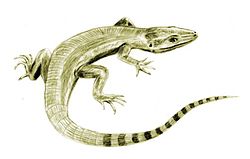Archaeothyris
| Archaeothyris Temporal range: Upper Carboniferous
| |
|---|---|

| |
| Archaeothyris | |
| Scientific classification | |
| Kingdom: | |
| Phylum: | |
| Superclass: | |
| Class: | |
| Order: | |
| Genus: | Archaeothyris
|
| Species: | A. florensis
|
| Binomial name | |
| Archaeothyris florensis Reisz, 1972
| |
Archaeothyris was one of the earliest definite synapsids. It lived in the late Carboniferous period, 306 million years ago.[1]
It shares this fame with another species (Echinerpeton) about which little is known. Protoclepsydrops is even slightly older, but only fragments have been found.
Archaeothyris was found in Nova Scotia, in the same area as several other species which were probably sauropsids: Hylonomus, and Petrolacosaurus.
Archaeothyris belonged to a group of early pelycosaurs which evolved early in the Pennsylvanian. It is thus seen as the precursor of all synapsids (which include mammals).
Appearance and lifestyle[change | change source]
Unlike the early sauropsids, Hylonomus and its kin, Archaeothyris was relatively large, measuring 50 centimetres (20 in) head to tail. It was also more advanced than the early sauropsids (~reptiles), with strong jaws that could open wider than those of the sauropsids. Its sharp teeth were all of the same shape, and it had a pair of enlarged canines, suggesting that it was a carnivore.[2]
Archaeothyris lived in what is now Nova Scotia, about 306 million years ago in the Carboniferous Period (Pennsylvanian).[3] Nova Scotia was at this time a swamp, similar to today's Everglades in Florida. The 'trees' (actually giant clubmosses) were very tall. Some, such as Lepidodendron, were up to 50 metres (164 feet) tall. Archaeothyris and the other early amniotes lived on the forest floor.
References[change | change source]
- ↑ Falcon-Lang H.J; Benton M.J. & Stimson M. 2007. Ecology of early reptiles inferred from Lower Pennsylvanian trackways. Journal of the Geological Society, London, 164, #6. 1113-1118
- ↑ Palmer, D., ed. (1999). The Marshall illustrated encyclopedia of dinosaurs and prehistoric animals. London: Marshall Editions. p. 186. ISBN 1-84028-152-9.
- ↑ Hess J.C & Lippolt H.J. 1986. 40Ar/39Ar ages: new calibration points for the improvement of the Upper Carboniferous time scale. Chem Geol 59: pp 143–154
- Kemp, T.S. (2005). The origin & evolution of mammals. Oxford: Oxford University Press. ISBN 0198507615.
